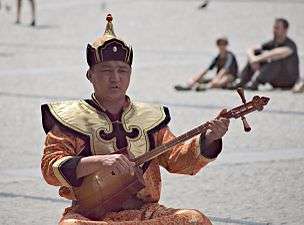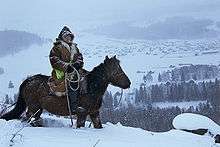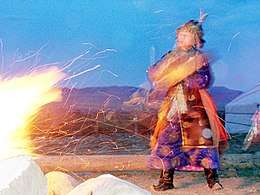Tuvans
The Tuvans or Tuvinians (Tuvan: Тывалар, Tıvalar; Mongolian: Тува, Tuva) are an indigenous people of Siberia[3] who live in Tuva, Mongolia, and China. They speak Tuvan, a Siberian Turkic language.[4] They are also regarded in Mongolia as one of the Uriankhai peoples.[5]
 Tuvan throat singer. | |
| Total population | |
|---|---|
| c. 300,000 | |
| Regions with significant populations | |
| c. 25,000[1] | |
| 5,169 | |
| c. 3,900 (as Mongol) | |
| 43[2] | |
| Languages | |
| Tuvan, Russian, Mongolian, Chinese | |
| Religion | |
| Predominantly: Tibetan Buddhism ("Lamaism"), Tengrism Minority: Orthodox Christianity, Atheism | |
| Related ethnic groups | |
| Ket people, Turkic and Mongol peoples. | |
Tuvans have historically been cattle-herding nomads, tending to herds of goats, sheep, camels, reindeer, cattle and yaks for the past thousands of years. They have traditionally lived in yurts covered by felt or chums, layered with birch bark or hide that they relocate seasonally as they move to newer pastures. Traditionally, the Tuvans were divided into nine regions called khoshuun, namely the Tozhu, Salchak, Oyunnar, Khemchik, Khaasuut, Shalyk, Nibazy, Daavan and Choodu, and Beezi. The first four were ruled by Uriankhai Mongol princes, while the rest were administered by Borjigin Mongol princes.[6]
History
Besides prehistoric rock-carvings to be found especially along the Yenisei banks, the first internationally important archaeological findings have been near Arzhan, in the north central Tuva. Here, Scythian kurgan burials are being researched, revealing the earliest (7th, 6th century BC) and easternmost remains of these people who spread all the way from Central Asia. Their story and fantastic gold treasures can be appreciated in the National Museum in Kyzyl.
The Xiongnu ruled over the area of Tuva prior to 200 AD. At this time, a people known to the Chinese as Dingling 丁零 inhabited the region. The Chinese recorded the existence of a tribe of Dingling origin named Dubo in the eastern Sayans. This name is recognized as being associated with the Tuvan people and is the earliest written record of them. The Sibes(Xianbei 鮮卑 or Tunghu 東胡 in Chinese) attacked and defeated the Xiongnu and they, in turn, were defeated by the Rouran 柔然. From around the end of the 6th century, the Göktürks held dominion over Tuva up until the 8th century when the Uyghurs took over.

Tuvans were subjects of the Uyghur Khanate during the 8th and 9th centuries. The Uyghurs established several fortifications within Tuva as a means of subduing the population. There are plans being discussed to restore the remains of one of these fortresses, Por-Bazhyn in lake Tere-Khol in the southeast of the country.[7] The memory of Uyghur occupation could still be seen up until the end of the 19th century due to the application of the name Ondar Uyghur for the Ondar Tuvans living near the Khemchik river in the southwest.[8] Uyghur dominance was broken by the Yeniseian Kyrgyz in 840 AD, who came from the upper reaches of the Yenisei.
In 1207, the Oirat prince Quduqa-Beki led Mongol detachments under Jochi to a tributary of the Kaa-Khem river. They encountered the Tuvan Keshdims, Baits, and Teleks. This was the beginning of Mongol suzerainty over the Tuvans. After the collapse of the Naiman Khanate, Tuvans moved to modern Mongolia and some Naimans moved to modern Kazakhstan territory.
Tuvans came to be ruled for most of the 17th century by Khalka Mongol leader Sholoi Ubashi's Altan-Khan Khanate. It was at this time in 1615 that the first Russians, Vasily Tyumenets and Ivan Petrov, visited Tuva as emissaries to the Altan-Khan.[9] Russian documents from this time record information about different tribal groups that contributed to the composition of modern Tuvans. Tyumenets and Petrov describe the Maads, who became Russian subjects in 1609, living in the Bii-Khem basin, 14 days' ride from Tomsk. The Maads travelled to the area of the Khemchik and Ulug-Khem next to the lands of the Altan-Khan near the lake Uvs Nuur. The ambassadors also described the Sayan raising reindeer with the Tochi (Todzhi) from the Sayan to the Altai mountain ranges. The descendants of the Ak-Sayan and Kara-Sayan live mostly around Tere-Khol rayon.

The state of the Altan-Khan disappeared due to constant warring between the Oirats and the Khalka of Jasaghtu Khan aimag. The Tuvans became part of the Dzungarian state ruled by the Oirats. The Dzungars ruled over all of the Sayano-Altay Plateau until 1755. It was during this time of Dzungarian rule that many tribes and clans broke up, moved around, and intermingled. Groups of Altayan Telengits settled in western Tuva on the Khemchik and Barlyk rivers and in the region of Bai-Taiga. Some Todzhans, Sayans, and Mingats ended up in the Altay. The Siberians(Xianbei) established Manchu-Qing Dynasty migrated other Tuvans north across the Sayan range and they became known as Beltirs (Dag-Kakpyn, Sug-Kakpyn, Ak-Chystar, Kara-Chystar). The languages of the Beltirs and Tuvans still contain common words not found in the language of the other Khakas (Kachins or Sagays).[10] Other Russian documents mention Yeniseian Kyrgyz (Saryglar and Kyrgyz), Orchaks (Oorzhaks) and Kuchugets (Kuzhugets) moving into Tuva from the north.
Besides the Turkic tribes mentioned above, there is indication that modern Tuvans are descended also from Mongolic, Samoyedic, and Yeniseian groups of peoples. Of the extinct Southern Samoyed groups, Mator, Koibal, Kamas, and Karagas were assimilated mostly into the eastern Tuvans such as the Todzhins, Tofalars, Soyots, and Dukha. The Irgit tribe is also suggested as being from Samoyedic ancestors.[11] The Tuvan name for the Yenisei river may stem from an ancient Samoyedic name.[12] Tribes such as Tumat, Mingat, Mongush, and Salchak are recognized as having a Mongolic origin.[13]
According to Ilya Zakharov of Moscow's Vavilov Institute of General Genetics, genetic evidence suggests that the modern Tuvan people are the closest genetic relatives to the indigenous peoples of the Americas.[14] A recent (2016) study claims that Tuvans and some other Siberian Turkic groups are descendants of the Yeniseian people and closely related to the Paleo-Eskimo groups.[15]
The name Uriankhai

There does not seem to exist a clear ethnic delineation for the application of the name Uriankhai. Mongols applied this name to all tribes of Forest People. This name has historically been applied to Tuvans. In Mongolia there are peoples also known by this name. A variation of the name, Uraŋxai, was an old name for the Sakha.[16] Russian Pavel Nebol'sin documented the Urankhu clan of Volga Kalmyks in the 1850s.[17] Another variant of the name, Orangkae (오랑캐), was traditionally used by the Koreans to refer indiscriminately to "barbarians" that inhabited the lands to their north.
They are two groups under the name Uriankhai: Mongol Uriankhai, Uriankhai (Tuva) of mixed Mongol-Turkic origin. All clans of the Mongol Uriankhai are Mongol, and Tuva Uriankhais have both Mongol and Turkic clans.[18][19] In the beginning of the Mongol Empire (1206–1368), the Mongol Uriankhai (Burkhan Khaldun Uriankhai) were located in central Mongolia[20] but in the mid 14th century they lived in Liaoyang province of modern China. In 1375, Naghachu, Uriankhai leader of the Mongolia-based colonial dynasty in Liaoyang province invaded Liaodong with aims of restoring the Mongols to power. Although he continued to hold southern Manchuria, Naghachu finally surrendered to the Chinese Ming dynasty in 1387–88 after successful diplomacy of the latter.[21] After the rebellion of the northern Uriankhai people, they were conquered by Dayan Khan in 1538 and mostly annexed by the northern Khalkha. Batmunkh Dayan Khan dissolved Uriankhai tumen and moved them to Altai Mountains and Khalkha land.
Currently, Tuvans form the majority of the population in Tuva Republic. According to the 2010 Russian census, there was a total of 249,299 Tuvans who resided within Tuva. This represented 82.0% of the total population of the republic. In addition, Tuvans have a much higher fertility rate than Russians and the other Slavic peoples, while the median age of the Tuvan population is much lower than Russians. This basically ensures that the Tuvan population would continue to grow during the foreseeable future.
Geography
There are two major groups of Tuvans in Tuva: Western Tuvans and Tuvans-Todzhins (Тувинцы-тоджинцы). The latter ones live in Todzhinsky District, Tuva Republic and constitute about 5% of all Tuvans.
A people similar by language to Tuvans live in Oka District of Buryatia (autonym: Soyots (сойоты), sometimes referred to as Oka Tuvans).
Mongolia
A noticeable proportion of Tuvans lives in Mongolia. The Dukha live in Khövsgöl Aimag. The largest population of Tuvans in Mongolia are the Tsengel Tuvans.[22] Around 1,500 live in Tsengel Sum of Bayan-Ölgii Aimag. Other Tuvans live in Khovd Aimag and in Ubsunur Hollow.
China
Tuvans in China, who live mostly in the Xinjiang Autonomous Region, are included under the Mongol nationality.[22] Some Tuvans reportedly live at Lake Kanas in the northwestern part of Xinjiang in China where they are not officially recognized, are counted as a part of the local Oirat Mongol community that is counted under the general label "Mongol". Oirat and Tuvan children attend schools in which they use Chakhar Mongolian[23] and Mandarin Chinese, native languages of neither group.
Culture


The famous bogtag headdress worn by women seems to have been restricted to married women of very high rank.[24] Also this headdress worn by the Tuvan women of very high rank in the 13th century.
Language
The Tuvan language belongs to the Northern or Siberian branch of the Turkic language family. 70% of the lexis is Turkic and the remaining 30% is Mongolic. Four dialects are recognized: Central, Western, Southeastern and Northeastern (Todzhinian). In writing, a variety of the Cyrillic script is used. A talking dictionary is produced by Living Tongues Institute.[25]
Religion
The traditional religion of Tuvans is a type of Tengriism, or Turkic animistic shamanism. The religion is still widely practiced alongside Tibetan Buddhism.
Traditional life
The Tuvans were mainly semi-nomadic livestock herders. They raised sheep, horses, reindeer, cattle, and yaks. Today, some Tuvans still retain their semi-nomadic way of life. The mobile dwellings of the Tuvans were usually circular yurts used in the steppes or conical hide tents when they were near or inside a forest.[26]
Music
A unique form of music exists in Tuva – commonly known as throat singing or as khoomei. There are various techniques of khoomei, some giving the effect of multiple tones by emphasizing overtones. Some famous groups from Tuva who feature throat-singing are Yat-Kha, Huun-Huur-Tu, Chirgilchin and the Alash Ensemble.
A documentary called Genghis Blues was made in 1999 about an American blues/jazz musician, Paul Pena, who taught himself overtone singing and traveled to Tuva to compete in a throat-singing competition.[27]
Notable people
- Galsan Tschinag
- Khertek Anchimaa-Toka
- Khün Khürtü
- Sergey Shoygu (Russian politician)
- Kongar-ol Ondar
- Mongush Kenin-Lopsan (shaman and ethnographer)
See also
- List of indigenous peoples of Russia
- List of Tuvans
- Tuva
- Tannu Uriankhai
- Por-Bazhyn
Notes
- Russian Census 2010: Population by ethnicity (in Russian)
- State statistics committee of Ukraine – National composition of population, 2001 census (Ukrainian)
- "Y-DNA haplogroups of Tuvinian tribes show little effect of the Mongol expansion". Indo-European.eu. Retrieved 2020-07-15.
- "CNBC Asia-Pacific: Network Schedule". Advameg, Inc. everyculture.com.
- "Uriyangqad, which is the plural form of Uriyangqan, itself originally a plural of Uriyangqai."
KRUEGER, John (1977). Tuvan Manual. p. 10. Which quotes from Henry Serruy's "The Mongols in China during the Hung-wu Period", Melanges chinois et bouddhiques, vol 11. pp. 282–283, Brussels 1959. - The Uralic and Altaic Series By Denis Sinor, John R. Krueger, Jüri Kurman, Larry Moses, Robert Arthur Rupen, Vasilij Vasilevič Radlov, Kaare Grłnbech, George Kurman, Joshua A. Fishman, Stephen A. Halkovic, Robert W. Olson, V Diószegi, American Council of Learned Societies, Melvin J. Luthy, Luc Kwanten, Karl Nickul, A. A. Popov, Susan Hesse, Routledge, 1996.
- "Tuva-Online: Ancient Uyghur Fortress on a Tuvan Lake to Turn into a R…". archive.is. 18 September 2012. Archived from the original on 18 September 2012.
- KRUEGER, John (1977). Tuvan Manual. p. 41.
which cites from POTAPOV, L.P. (1964). "The Tuvans". The Peoples of Siberia. - KRUEGER, John (1977). Tuvan Manual. p. 25.
which cites from an English translation of Большая Советская Энциклопедия (The Great Soviet Encyclopedia). 43. 1956. Missing or empty|title=(help) by William H. Dougherty. - KRUEGER, John (1977). Tuvan Manual. p. 42.
which cites from POTAPOV, L.P. (1964). "The Tuvans". The Peoples of Siberia. - DERENKO, M.V.; et al. (March 2002). "Polymorphism of the Y-Chromosome Diallelic Loci in Ethnic Groups of the Altai-Sayan Region". Russian Journal of Genetics. 38 (3): 309–314. doi:10.1023/A:1014863020171. Archived from the original on 2007-10-22. Retrieved 2010-10-23. Mentions that "some authors" suggest this idea.
- VÁSÁRY, I. (1971). "Käm: an Early Samoyed Name of Yenisei". Studia Turcica: 469–482.
- DERENKO, M.V.; et al. (March 2002). "Polymorphism of the Y-Chromosome Diallelic Loci in Ethnic Groups of the Altai-Sayan Region". Russian Journal of Genetics. 38 (3): 309–314. doi:10.1023/A:1014863020171. Archived from the original on 2007-10-22. Retrieved 2010-10-23. Mentions only Mongush and Salchak tribes.
- "Central Asian Origins of the Ancestor of First Americans", by I. Zakharov Archived 2007-03-10 at the Wayback Machine (in Russian)
- Flegontov, Pavel; Changmai, Piya; Zidkova, Anastassiya; Logacheva, Maria D.; Altınışık, N. Ezgi; Flegontova, Olga; Gelfand, Mikhail S.; Gerasimov, Evgeny S.; Khrameeva, Ekaterina E. (2016-02-11). "Genomic study of the Ket: a Paleo-Eskimo-related ethnic group with significant ancient North Eurasian ancestry". Scientific Reports. 6: 20768. arXiv:1508.03097. Bibcode:2016NatSR...620768F. doi:10.1038/srep20768. PMC 4750364. PMID 26865217.
- POPPE, Nicholas (1969). "Review of Menges "The Turkic Languages and Peoples"". Central Asiatic Journal. 12 (4): 330.
- Mänchen-Helfen, Otto (1992) [1931]. Journey to Tuva. Los Angeles: Ethnographic Press University of Southern California. p. 180. ISBN 978-1-878986-04-7.
- Б.Цэрэл. Дөрвөн Ойрад ба Ойрадын холбоонд багтах үндэстэн ястнуудын угсаа түүхийн зарим асуудал. 1997
- B.Tserel. Tribes of the Oirat confederation. 1997
- Crossley, Pamela Kyle (December 1985). "An Introduction to the Qing Foundation Myth". Late Imperial China. 6 (2): 13–24. doi:10.1353/late.1985.0016.
- Willard J. Peterson, John King Fairbank, Denis Twitchett- The Cambridge History of China, vol7, p.158
- Mongush, M. V. "Tuvans of Mongolia and China." International Journal of Central Asian Studies, 1 (1996), 225–243. Talat Tekin, ed. Seoul: Inst. of Asian Culture & Development.
- "Öbür mongγul ayalγu bol dumdadu ulus-un mongγul kelen-ü saγuri ayalγu bolqu büged dumdadu ulus-un mongγul kelen-ü barimǰiy-a abiy-a ni čaqar aman ayalγun-du saγurilaγsan bayidaγ." (Sečenbaγatur et al. 2005: 85).
- "Mongolian Dress".
- "Tuvan Talking Dictionary". tuvan.swarthmore.edu. Retrieved 2015-09-28.
- Winston, Robert, ed. (2004). Human: The Definitive Visual Guide. New York: Dorling Kindersley. p. 429. ISBN 0-7566-0520-2.
- "Genghis Blues" – via www.imdb.com.
References
- DERENKO, M.V.; et al. (March 2002). "Polymorphism of the Y-Chromosome Diallelic Loci in Ethnic Groups of the Altai-Sayan Region". Russian Journal of Genetics. 38 (3): 309–314. doi:10.1023/A:1014863020171. Archived from the original on 2007-10-22. Retrieved 2010-10-23.
- Hoppál, Mihály (2005). Sámánok Eurázsiában (in Hungarian). Budapest: Akadémiai Kiadó. ISBN 978-963-05-8295-7. The title means “Shamans in Eurasia”, the book is published also in German, Estonian and Finnish. Site of publisher with short description on the book (in Hungarian) Archived 2010-01-02 at the Wayback Machine.
- KRUEGER, John R. (1977). John R. Krueger (ed.). Tuvan Manual. Uralic and Altaic Series Volume 126. Editor Emeritus: Thomas A. Sebeok. Indiana University Publications. ISBN 978-0-87750-214-2.
- MONGUSH, M.V. (1996). "Tuvans of Mongolia and China". International Journal of Central Asian Studies. 1: 225–243.
- OYUN, Dina (2006-11-16). "Ancient Uigur Fortress on a Tuvan Lake to Turn into a Recreation and Tourist Centre". Tuva Online. Archived from the original on 2012-09-18. Retrieved 2007-02-05.
- PAVLINSKAYA, Larisa R. (Spring 2003). "The Troubled Taiga: Survival on the Move for the Lost Nomadic Reindeer Herders of South Siberia, Mongolia, and China". Cultural Survival Quarterly. 27 (1): 45–47. Archived from the original on 2006-12-30. Retrieved 2007-02-05.
- (in Mongolian) Sečenbaγatur, Qasgerel, Tuyaγ-a [Туяa], Bu. Jirannige, Wu Yingzhe, Činggeltei. 2005. Mongγul kelen-ü nutuγ-un ayalγun-u sinǰilel-ün uduridqal [A guide to the regional dialects of Mongolian]. Kökeqota: ÖMAKQ. ISBN 7-204-07621-4.
- XIAOLEI, Jing (2007-01-07). "The Winds of Change". Beijing Review No. 46. Retrieved 2007-02-05.
- ZAKHAROV, I.A. (2003). "Central Asian Origins of the Ancestor of First Americans (Центральноазиатское происхождение предков первых американцев)". 2003 (in Russian). pp. 139–144. Archived from the original (Первые американцы. № 11.) on 2007-03-10. Retrieved 2007-02-05.
External links
![]()
- Research among the Tyvans in South Siberia
- "Reindeer People" Resort to Eating Their Herds (about the Dukha) with Photo gallery
- Tuva – Sayan Mountains
- Singing Stones – The Republic of Tuva